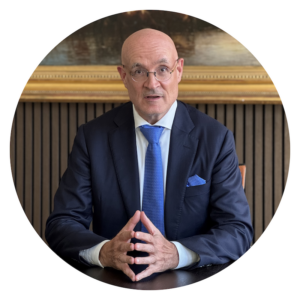We are pleased to open our new interview series with Dr. iur. Alexander Lindemann, partner at LINDEMANNLAW and President of the Swiss Capital Market Forum. He advises investment funds, asset managers, private clients, and banks on legal, regulatory, and tax matters.
In this first edition, Dr. Lindemann shares his perspective on what the U.S. Appeals Court ruling on Trump’s tariffs means for Switzerland.
Background
In April 2025, President Donald Trump invoked the International Emergency Economic Powers Act (IEEPA) to impose tariffs on most U.S. imports. Several parties filed lawsuits asserting that IEEPA does not give the President legal authority to impose these tariffs.
In May, two federal trial courts ruled that the tariffs imposed under IEEPA exceeded the scope of the President’s authority. Both of the trial courts paused (stayed) their own rulings so the tariffs could stay in effect while the government appealed to higher courts.
In a recent en banc decision, the U.S. Court of Appeals for the Federal Circuit ruled against most of former President Trump’s new tariffs.
Q: What did the appeals court actually decide?
 A (Dr. Lindemann): On 29 August 2025, the Federal Circuit held, by a 7–4 majority, that the Administration lacked the authority under the IEEPA to impose broad, across-the-board tariffs. The Act is designed to regulate specific transactions in response to extraordinary threats, not to reset the U.S. tariff schedule. As a result, most IEEPA-based tariffs were deemed unlawful. Importantly, the decision does not affect tariffs imposed under other statutes, such as Section 232 national-security tariffs or Section 301 measures against China. [1]
A (Dr. Lindemann): On 29 August 2025, the Federal Circuit held, by a 7–4 majority, that the Administration lacked the authority under the IEEPA to impose broad, across-the-board tariffs. The Act is designed to regulate specific transactions in response to extraordinary threats, not to reset the U.S. tariff schedule. As a result, most IEEPA-based tariffs were deemed unlawful. Importantly, the decision does not affect tariffs imposed under other statutes, such as Section 232 national-security tariffs or Section 301 measures against China. [1]
Law/cases cited: IEEPA, 50 U.S.C. §§ 1701–1707; Federal Circuit decision (en banc) reported [1]; background on unaffected Section 232/301 from CRS. [2]
Q: Do the tariffs come off now? What’s the timeline?
A: Not immediately. The appeals court stayed the effect of its ruling, leaving the IEEPA tariffs in place while the Administration seeks Supreme Court review. An emergency application and a certiorari petition are expected by mid-October. If the Supreme Court declines review, or confirms the Federal Circuit’s reasoning, then these tariffs must be removed, and companies could pursue refunds. Until then, however, the duties remain payable.
Q:Why did the court say IEEPA can’t be used for general tariffs?
A: The judges emphasized that IEEPA authorizes targeted action – blocking or regulating certain transactions – not a wholesale reconfiguration of trade policy. They drew on the “major questions doctrine,” most recently applied in West Virginia v. EPA, which requires clear congressional authorization for policies with vast economic or political impact. They also referenced the classic Youngstown case on separation of powers. Since Congress never granted explicit authority for global tariffs under IEEPA, the Administration’s action exceeded its mandate. [3]
Law/cases cited: West Virginia v. EPA, 597 U.S. ___ (2022); Youngstown Sheet & Tube Co. v. Sawyer, 343 U.S. 579 (1952). [3]
Q: Does this touch Section 232 steel/aluminum or other tariffs?
A: No. Section 232 tariffs on steel and aluminum, or Section 301 tariffs targeting China, remain in force. These measures rest on entirely different statutes and have been upheld in previous litigation. This ruling is strictly limited to tariffs imposed under IEEPA. For Swiss exporters, this means that Section 232 exposures remain unchanged and must still be factored into trade planning.
Law/cases cited: Trade Expansion Act § 232, 19 U.S.C. § 1862; AIIS v. United States; Transpacific Steel. [4]
Q: What does this mean for Switzerland, practically?
A: Switzerland is directly affected, since it is currently subject to the IEEPA-based “reciprocal” tariff package – including the 39% surcharge announced in August 2025. If the Federal Circuit’s decision stands, these surcharges will have to be removed, and refunds could become available. [5]
For now, however, they remain payable. Swiss exporters should act prudently:
- File timely protests with U.S. Customs to preserve refund rights.
- Keep duty drawback options open.
- Adjust contracts for price, Incoterms, and include hardship or force-majeure clauses to mitigate risk while the Supreme Court process is pending.
Note: non-IEEPA tariffs (e.g., Section 232 on steel/aluminum) are unaffected by this decision, so exposures there persist.
Swiss-specific sources & guidance: SECO’s Switzerland–U.S. trade page (notes the 39% measure and exemptions).
Bonus question: What should companies do right now?
 A: First, map your exposure carefully. Distinguish between IEEPA-based tariffs, which may ultimately be reversed, and Section 232/301 tariffs, which remain in force. Second, document everything – entry summaries, proof of payment, protest deadlines. Finally, scenario-plan for both possible Supreme Court outcomes: one where tariffs drop to zero, and another where they remain in place. This preparation ensures that Swiss companies are not caught off guard, regardless of how the litigation unfolds.
A: First, map your exposure carefully. Distinguish between IEEPA-based tariffs, which may ultimately be reversed, and Section 232/301 tariffs, which remain in force. Second, document everything – entry summaries, proof of payment, protest deadlines. Finally, scenario-plan for both possible Supreme Court outcomes: one where tariffs drop to zero, and another where they remain in place. This preparation ensures that Swiss companies are not caught off guard, regardless of how the litigation unfolds.
For tailored advice on U.S.–Swiss trade relations, tariff exposure, and international contract structuring, please contact LINDEMANNLAW’s International Trade & Cross-Border Practice.
Further Reading: Dr. Alexander Lindemann provided additional perspectives on this topic in an interview with SonntagsBlick. The full interview can be accessed here (German).
Sources
[1] 25-1812.OPINION.8-29-2025_2566151.pdf
[2] Congres.gov
[3] supremecourt.gov, Youngstown Sheet & Tube Co. v. Sawyer | 343 U.S. 579 (1952) |
[5] seco.admin.ch
Disclaimer: This publication is for general information purposes only and does not constitute legal advice. For legal advice on your specific situation, please contact us directly.


